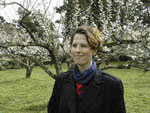 |
 |
Ruth Reiner
11. The world
After Onisaburo’s release on bail during the first Oomoto persecution, Onisaburo began the dictation of the “Reikai Monogatari”, that I’ve mentioned in the past, which means: Stories from the spiritual world.
This work is said to be based on his experiences while practicing asceticism on Mount Takakuma near his home village, at the age of twenty-six.
The Reikai Monogatari includes, among other things, prophesies and poems. It covers all issues of existence, from the divinity of the supreme god, the creation of the universe, morality, economics, politics, love, arts and many more...
As Onisaburo produced these volumes at incredibly high speed, and printed an enormous number of copies, the authorities began to watch with increasing suspicion. Eventualy, the authorities insisted on having the works go first through Censorship before publication. Certain volumes were even banned from sale.
To get the feeling of how great Onisaburo’s drive was to let out all that he has realized. Until the Second Oomoto incident, eighty-one volumes were issued; each volume has in average about three-hundred and fifty pages. So if rouphly calculated, that is about four to five volumes a year.
Filled with his great passion to spread the Monogatari, despite the interference of the authorities, Onisaburo decided to find also alternative ways. He formed reading circles, put melodies to the texts, made people practice reciting it, he even developed plays and operas. Eventually even put it on film.
(As I was reading this, it really made me want to ask about watching one of these films. Well, at this moment there is no one in the office... But I am going to check on that for sure).
It is said in the book that the dictation was done to the sounds of the destruction of the sanctuaries by the authorities...
On the first of September 1923, The Great Kanto Earthquake hit Tokyo and it’s surrounding areas and some 90,000 people were killed. At that time Onisaburo was on the Island of Kyushu. Not long before, Onisaburo referred to a passage from the Ofudesaki (The sacred writings of Oomoto): “Tokyo will become a burnt wilderness”. And so now, after this great tragedy occurred, Onisaburo was approached in this sudden chaos by crowds of people, and newspapers, from all around the country.
This is only one of the two horrifying incidents of that same year that Onisaburo had predicted. Another one I would like to bring to you as told in chapter 20 of the book:
“...Onisaburo was in the middle of a meeting with someone when he suddenly cried in surprise, “Ah, Takashi Hara has been killed.” When people asked him what he had seen, Onisaburo said, “He has been attacked by a youth at the Tokyo Station.” When they suggested to him that he warn the Prime Minister, Onisaburo replied, “Things that happen in the Spiritual World manifest themselves in this world, so it is no use warning him now.” It was about two hours later that Takashi Hara was assassinated.”
“At a later date, when a certain youth asked, “What is the spiritual eye like?” Onisaburo replied, “It looks like moving pictures, but it is difficult to tell the time that the events seen are taking place.”
It seems to me that Onisaburo had the ability to live at the same time in many different worlds. One would be the spiritual world, another would be this world (with a reality that required gross concrete decision-making and net-working), as well as in his artistic world. Some may argue with me and say that these are all of the same world. That is understandable, but the capacity to juggle between all these different scenes simultaneously, seems to me magnificent.
We can see that even though a “great earthquake” also hit Oomoto in those years in great strength, the outcomes lead to the further progress of Oomoto. Overseas activities sprung up with the Esperanto movement and also with the birth of the Jinrui Aizenkai (Universal Love and Brotherhood Association).
“It is said that Onisaburo first showed interest in Esperanto (between 1912-1926)... He arrived at the idea while he was studying passages in the Ofudesaki (the sacred automatic writings I’ve mentioned before, dictated to the foundress of Oomoto Nao Deguchi), dealing with “the abc of the world...” He realized at a fairly early stage the need for the existence of a common language neutral to all countries of the world, but it was only later that he found that the concrete answer to this need - - Esperanto - - actually existed”. (ch 20)
Here in chapter 20 of the book we are told that in May 1923, Onisaburo ordered a woman called Haruko Kato to begin learning Esperanto. In July teachers came to Ayabe by invitation and began to hold classes. And then we read this cute passage, which Mr. Kyotaro Deguchi adds about his grandfather:
“And so, needless to say, Onisaburo studied passionately, and as early as August, he surprised everyone by writing an Esperanto book.”
And so Oomoto began dealing with international activities at that time beyond the adoption of the language of Esperanto. Next time, I would like to share with you a bit from of the world outside Japan in the 1920’s... and Oomoto’s connection with it.
| up to the index | ||
Home |
||